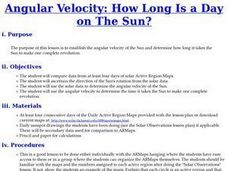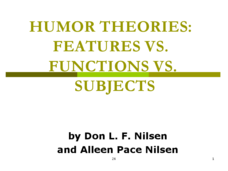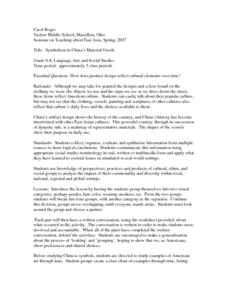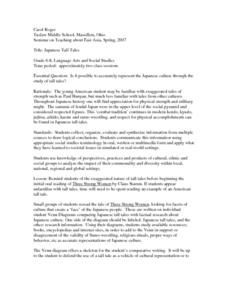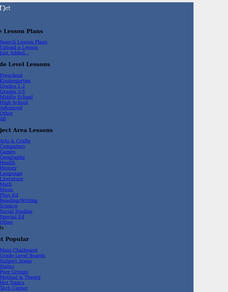Curated OER
Roger That!
Students study the letter R, r in order to recognize it, say its sound, and write it. They watch a partner's mouth as they make the "r" sound before repeating a tongue twister that contains many "r" sounds. Next, they practice writing...
Curated OER
Dancing a Christmas Carol
Students explore dance. They analyze and outline the movements of the dance "Roger de Coverly" from Charles Dickens' A Christmas Carol. Students choose music and choreograph a dance similar to "Roger de Coverly." They perform the dance....
Curated OER
Amelia Bedelia (Persuasive Writing)
Students read and discuss the book "Amelia Bedelia". They brainstorm all of the options certain characters in the book could have done instead of what they chose to do. They decide if the decision was a good or bad. They write a...
Curated OER
Heroes of the Revolutionary War
Eighth graders discuss as a class what a "hero" is and watch a PowerPoint presentation about George Rogers Clark and John Paul Jones. They then turn in their books and discuss some of the technology available to soldiers during the time...
Curated OER
2, 4, 6, 8 . . .What Do We Appreciate-Patterns, Patterns, Patterns
Learners discover and predict patterns in a numerical sequence. Through the Internet and video segments, students begin with basic number patterns and extend their knowledge into higher math skills. They will also create new patterns...
Curated OER
Teaching Biotechnology With Models
High schoolers will construct models to obtain understanding about the scientific concept. The kinesthetic learners will benefit from the project. There is ample opportunity for all types of learners to be engaged in this lesson.
Curated OER
Off to Camp We Go!
Students research the Civilian Conservation Corp camps. In this Civilian Conservation Corps camp, students explore the C. C. C. and Franklin Delano Roosevelt. They plan and develop a three dimensional representation of life in a C. C. C....
Curated OER
Charlotte's Web
Students examine the story, "Charlotte's Web" in the nine lessons of this unit. As the students progress through the book, they will explore the story plot, setting, character, and the value of friendship.
Curated OER
Gases and Plasmas
Young scholars determine what plasma is and why the sun is made up of plasma. They recognize situations where plasmas are found in nature and made by man. They discuss why the sun is a huge ball of plasma and if there are different...
Curated OER
Was Kepler Correct?
Learners are introduced to Kepler's 2nd law of Planetary Motion. The instructional activity reinforces the understanding of focal points. They calculate the sector area of an ellipse.Students expand understanding by modeling Kepler's 2nd...
Curated OER
Fusion Confusion
Students are introduced to three types of energy transfer: conduction, convection, and radiation. They model the scientific process of fusion to become with the sun and how it produces energy.
Curated OER
Solar Surfing
Students explore sources of solar astronomy. They use the internet to identify web pages associated with solar observatories, astronomical organizations, and educational sights associated with both. Students identify the type of...
Curated OER
Graphing the Facts
Pupils investigate the correlation between our planet's weather and solar activity. They analyze and discuss data regarding the solar activity cycle, graph annual precipitation and temperature averages over a period of 100 years, and...
Curated OER
The Reformation
Learners reflect on the specific details surrounding the Reformation. In this World History lesson plan, students watch the film "Luther," then apply what they learned in their discussion on the Reformation with the film to...
Curated OER
Angular Velocity: How Long Is a Day on The Sun?
Students establish the angular velocity of the Sun and determine how long it takes the Sun to make one complete revolution. They determine what angular velocity is and how it can be useful in determining the speed and direction of any...
Core Knowledge Foundation
Weather or Not, Seasons Change
Embark on a year long investigation of the seasons with this 10-lesson earth science unit. After being introduced to different types of weather and the tools used to measure it, young scientists perform fun hands-on activities that...
Curated OER
Humor Theories: Features vs. Functions vs. Subjects
Great for a psychology, sociology, or language arts lecture, this presentation focuses on the features, functions, and subjects of humor. Complete with definitions and examples of each category, as well as links to humorous videos and...
Curated OER
Wetland Habitats
Eighth graders explore the program Alice and the Internet to research wetland habitats. In this habitat lesson students build their own Alice world that includes wetland habitats, food sources and ways to protect the...
Curated OER
Symbolism in China's Material Goods
Students make a generalization about the process of 'looking' and 'grouping', hoping to show that we, as Americans, show preferences and shared choices. They study examples of American art through time and create a class chart...
Curated OER
Japanese Tall Tales
Students read the tale of 'Three Strong Women' looking for facets of culture that create a 'face' of the Japanese people. They create a Venn Diagram comparing Japanese tall tales with factual research about Japanese culture. One side...
Curated OER
Lessons in Loss, Year of Impossible Goodbyes
Students determine how the Korean people dealt with the loss of their land and traditional lifestyle in response to invasion and emigration. They create a list of items and people they have lost. From this they complete a journal...
Curated OER
Was Kepler Correct?
Learners investigate the elliptical orbit around the Sun. They use the information gathered to measure the distance to the Sun from the closest orbital point and the farthest orbital point.
Curated OER
Language with Linguistic Legos
Young scholars visualize and manipulate sentences as building blocks, and, given a key, use Legos™ to demonstrate how to construct sentences of variety (simple, compound, complex, and compound-complex).
Curated OER
You are the Curator: Building a Museum of the 1920s and 1930s
Students examine primary and secondary sources regarding 1920's and 1930's America. In this Webquest lesson, students explore sources regarding the American decades in order to create their own museum exhibits.














